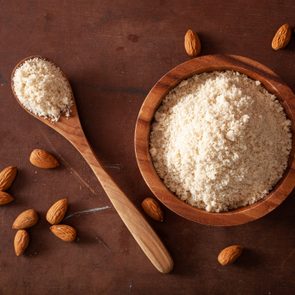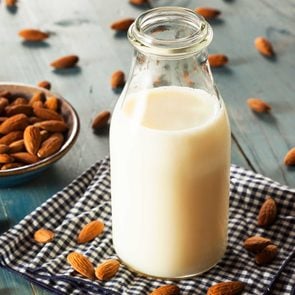Is Almond Milk Good for You? What to Know About Almond Milk Nutrition
Updated: Jun. 17, 2021
Plant-based milks like almond milk are giving dairy milks a run for their money, but are they any healthier for you?
Choosing an alternative milk
Plant or alt-based milks—including those made from nuts, seeds, legumes, or cereal grains—are increasingly popular. Buoyed by the healthful properties of almonds, almond milk stands out from this pack.
Almond milk is creamy and comes in many flavors and varieties, including vanilla, chocolate, honey, sweetened, and unsweetened, adding to its appeal.
But while whole almonds are rich in fiber, protein, the antioxidant powerhouse vitamin E, and more, does almond milk stack up?
Why almond milk?
There are several reasons that people turn away from dairy milks and toward almond milk and other dairy alternatives, says Lauri Y. Wright, PhD, RDN, a nutrition and dietetics associate professor at the University of North Florida, Tampa.
“Many people avoid dairy because they are lactose intolerant or have a milk allergy, or they chose a vegan or vegetarian lifestyle,” says Wright, who is also a spokesperson for the Academy of Nutrition and Dietetics. “There’s also an environmental benefit because almond milk leaves less of a carbon footprint than dairy milk.”
That said, a lot of nutrients get lost in the processing, says Wright. Almond milk is made by grinding almonds, soaking them in water, and then filtering this mixture to create a product that looks like milk, often with a nuttier flavor. (Here’s how to make almond milk at home for all the DIYers out there.)
“The almond is ground up and diluted in water, which means that a lot of the nutrient density gets lost,” she says. There’s less protein and fiber as a result of the processing.
Almond milk contains about 1 gram of protein per cup, while cow’s milk boasts around 8 grams of protein per cup. Protein is an essential building block for muscle, skin, and other body tissues. Of all the plant-based milks, soy milk has the most protein, Wright notes. (Here are the other nutritional differences in soy milk vs. almond milk.)
“You just don’t get the amount of protein in almond milk that you get with cow’s milk,” agrees Kristi Crowe-White, PhD, RD, associate professor and department chair, Department of Human Nutrition and Hospitality Management, The University of Alabama. (Here are 35 ways to get more protein.)
Some almond milks are enriched with calcium, vitamin D, and other nutrients that are removed during processing, she says.
Almond milk is also lower in fiber than a whole almond because milk is made using skinless almonds, and much of the fiber is found in the shell, Wright says. The liquids and solids are separated during the process, which also reduces fiber.
That’s not to say there aren’t health benefits associated with almond milk though, says Crowe-White, also an Institute of Food Technologists member expert.

Almond milk nutrition
It’s rich in vitamin E
Just like whole almonds, almond milk provides vitamin E, a potent antioxidant. Vitamin E benefits run the gamut. It helps fight off the damaging oxygen-free radicals that may contribute to heart disease and other health problems, Crowe-White says.
With 16.6 mg of vitamin E in a cup of almond milk, it provides 100 percent of the recommended dietary allowance for vitamin E, she says. This is even more vitamin E than what is found in whole almonds, because some companies enrich the milk with extra vitamin E. Read the label closely to know what exactly you are getting in your almond milk, she says.
It’s low in calories
Unsweetened almond milk is very low in calories, which is important if you are trying to lose weight. One cup of almond milk contains 30 to 50 calories. By contrast, a cup of skim milk has slightly more than 83 calories. Sweetened or flavored almond milks have more calories and more sugar, so it’s important to read the labels, Wright cautions. (Here’s how many calories you should eat to lose weight.)
It’s low in fat
Almond milk is diluted with water, which makes its fat content low. “These fats are predominantly healthy monounsaturated fats,” Crowe-White says. Monounsaturated fats are heart-healthy especially when they replace artery-clogging saturated fats in the diet.
It’s low in carbs
The carbohydrates in almond milk range from 1 to 5 grams. By contrast, a cup of nonfat cow’s milk contains 12 grams of carbs. Your body breaks down carbs into blood sugar or glucose for energy. If you have diabetes or are at risk for it, limiting carbs can help keep blood sugar balanced, according to the American Diabetes Association. There’s a caveat though. Many almond milks may be loaded with added sugar which can boost blood sugar or glucose levels, Wright notes.
It’s lactose free
If you experience bloating, diarrhea, and gas after you consume dairy foods, you could be lactose intolerant, and choosing almond milk and other almond based-products over dairy foods may alleviate those symptoms, Wright says. Lactose is the sugar found in milk and milk products. People who are lactose intolerant make low levels of the enzyme lactase and can’t digest lactose as a result.
It’s eco-friendly-ish
One glass of dairy milk results in almost three times more greenhouse gas emissions than any plant-based milk and uses nine times more land than any milk alternative, according to a study in Science. Greenhouse gas emissions contribute to global warming.
But almond production—which is booming in California—is not bee friendly.
Many of the bees brought in to pollinate almonds die due to insecticides that were initially thought to be safe for bees, finds a study in Insects. Many almond growers are now working to develop more bee-friendly practices to save the bees. Bees are tasked with helping all plants reproduce through pollination.
The last word
Assuming you don’t have an almond allergy, almond milk can offer some important health benefits, especially if you are lactose intolerant, vegan, or vegetarian. Some of the available almond milks may not be as nutritious as others because of added sugars.
Making your own almond milk can be a healthy alternative to store-bought varieties, explains Erika Laurion, a dietitian in Hudson, New York. Here’s how:
Almond Milk Recipe
Ingredients:
1 cup almonds
3 cups filtered fresh water
Vanilla
Maple syrup
Directions:
Soak almonds overnight in water.
Rinse. Add filtered fresh water. Put mixture in a high-speed blender until very smooth.
Use a special reusable nut milk bag and press from the bottom into a large bowl or pitcher.
Add vanilla and maple syrup to taste.
This keeps for up to a week in the refrigerator.























